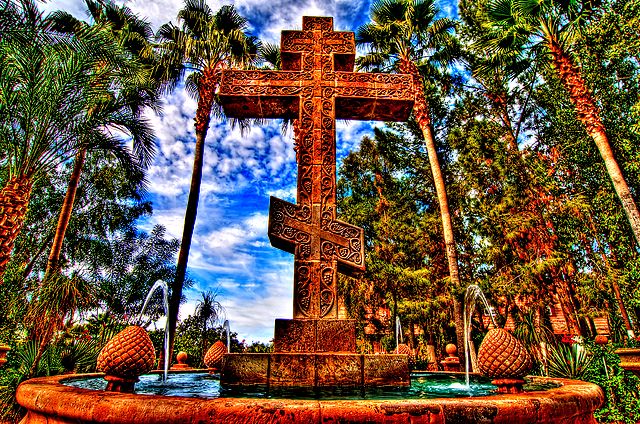Saint Anthony's Greek Orthodox Monastery - garden fountain - Florence, Arizona.
The symbol of the cross
is ubiquitous in society. It is printed on bumper stickers and tattooed
on forearms; it is spray painted on concrete walls and stitched onto
denim jackets; it adorns the necks of gangsta rappers as well as
scantily clad models. Is the cross merely a fashion statement, a
cultural icon, a religious trademark, or is it something more?
The cross is the third most
celebrated subject in the Orthodox Church calender—the first two being
the life of our Lord and the life of the Theotokos. The cross is
commemorated on the feast day of the Exaltation of the Holy Cross (14
September), on the feast day of the Veneration of the Holy Cross (the
third Sunday in Lent), and in the Thursday evening into Great Friday
services during Holy Week. The cross receives so much attention because
it is crucial for your understanding of the Christian faith. The word “crucial”—meaning decisive, critical, essential—comes from the Latin crux, from
which we derive our English word “cross.” In other words, the most
important event in history is what happened on the cross where Jesus
Christ was executed. That act is at the root of salvation and is the
basis for Christian theology. “Take therefore first, as an
indestructible foundation, the cross, and build upon it the other
articles of the faith” (St. Cyril of Jerusalem).
Reconciliation
There are many events in the
Old Testament that foreshadow the cross: the blood of a lamb placed on
lintels and doorposts during Passover (Exodus 12:23); Moses lifting his
staff and parting the Red Sea (Exodus14:16); Moses’ outstretched arms in
prayer for victory over Israel’s enemies (Exodus 17:8-15); and Israel
being saved from poisoning by looking at a bronze serpent on a pole
(Numbers 21:6-9). There are also prophetic allusions to the cross: the
curse of being hung on a tree (Deuteronomy 21:23); the predicted passion
of the Messiah (Psalm 22); the saving mark on the forehead (Exekiel
9:3-6, LXX; cf. Revelations 7:2-4; 22:4); and the blood that drips from
wood (2 Esdras 5:5). These references attest that the cross was always
part of God’s plan for salvation.
God reconciles His people by
delivering us from the consequences of sin, and the means God uses to
rescue us is the cross. Isaiah stated that the Messiah, “poured out his
life unto death and was numbered with the transgressors. For he bore the
sin of many, and made intercession for the transgressors” (Isaiah
53:12). The Apostle Paul confirmed this prophecy when he wrote, “For God
was pleased to have all his fullness dwell in [Christ], and through him
to reconcile to himself all things, whether things on earth or things
in heaven, by making peace through his blood, shed on the cross”
(Colossians 1:19-20; see also 2:13-15). Therefore the cross represents
God’s victory over sin:
“For the cross destroyed the enmity of
God towards man, brought about reconciliation, made the earth heaven,
associated men with angels, pulled down the citadel of death, unstrung
the force of the devil, extinguished the power of sin, delivered the
world from error, brought back the truth, expelled the demons, destroyed
temples, implanted virtue, [and] rounded the churches” (St. John
Chrysostom).
